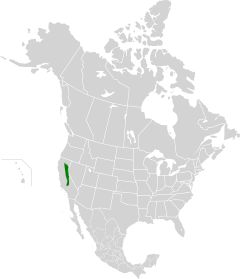Ecology of the Sierra Nevada
| Sierra Nevada forests | |
|---|---|

Subalpine forest at the base of Temple Crag
|
|
 |
|
| Ecology | |
| Biome | Temperate coniferous forests |
| Bird species | 197 |
| Mammal species | 103 |
| Geography | |
| Country | United States of America |
| State | California |
| Conservation | |
| Habitat loss | 1.0785% |
| Protected | 72.55% |
The ecology of the Sierra Nevada, located in the U.S. state of California, is diverse and complex: the plants and animals are a significant part of the scenic beauty of the mountain range. The combination of climate, topography, moisture, and soils influences the distribution of ecological communities across an elevation gradient from 1,000 feet (300 m) to over 14,000 feet (4,300 m). Biotic zones range from scrub and chaparral communities at lower elevations, to subalpine forests and alpine meadows at the higher elevations. Particular ecoregions that follow elevation contours are often described as a series of belts that follow the length of the Sierra Nevada. There are many hiking trails, paved and unpaved roads, and vast public lands in the Sierra Nevada for exploring the many different biomes and ecosystems.
The western and eastern Sierra Nevada have substantially different species of plants and animals, because the east lies in the rain shadow of the crest. The plants and animals in the east are thus adapted to much drier conditions.
The altitudes listed for the biotic zones are for the central Sierra Nevada. The climate across the north-south axis of the range varies somewhat: the boundary elevations of the biotic zones move by as much as 1,000 feet (300 m) from the north end to the south end of the range.
The lowest-elevation biotic zone in the Sierra Nevada is found along the boundary with the Central Valley. This zone, stretching in elevation from 500 to 3,500 feet (150 to 1,070 m), is the foothill woodland zone, an area that is hot and dry in the summer with very little or no snow in the winter. The foothills are vegetated with grasslands of mostly non-native grasses, mixed grasslands and woodlands savanna, a foothill woodland community of blue oak and gray pine, and chaparral. Many of the plant communities are similar to those found on the inner California Coast Ranges. Animals typical of this zone include black bear, ringtail cat, coyote, gray squirrel, bobcat, California mule deer, and skunk. In the foothills of the northern portion of the Sierra Nevada, toyon and chamise often co-dominate certain open serpentine chaparral communities.
...
Wikipedia
